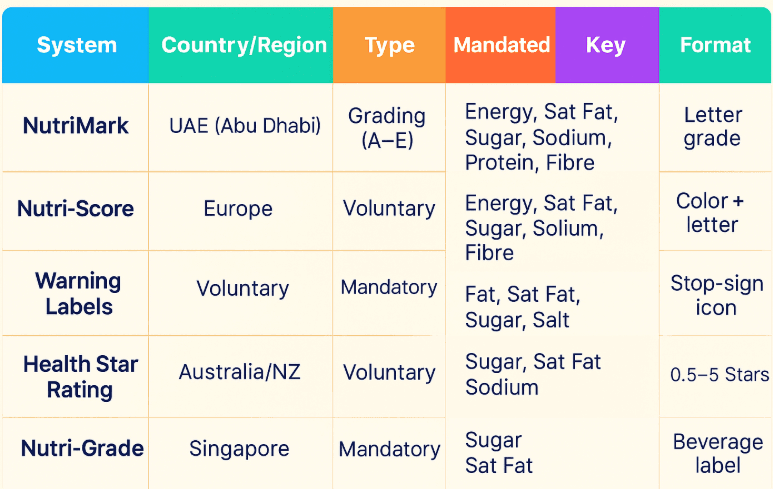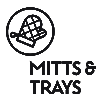Saudi Arabia Nutrition Labeling Requirements
Saudi Arabia has taken significant steps toward improving public health and fighting obesity by enforcing strict nutrition labeling regulations. The Saudi Food and Drug Authority (SFDA) mandates that restaurants, catering companies, and other food establishments display clear and accurate nutrition information on menus and product labels. Whether you run a full-service restaurant, manage an e-commerce food store, or sell prepackaged goods, here’s what you need to know to stay compliant with SFDA requirements and how NutriCal can help you streamline the process.
1. Why Saudi Arabia Is Prioritizing Nutritional Labeling
Saudi Arabia ranks among the top 20 countries worldwide in obesity prevalence, with around 40% of adults considered obese. In line with its Vision 2030 initiative to enhance quality of life, the country introduced comprehensive nutrition labeling requirements to:
- Empower consumers to make healthier eating decisions.
- Encourage food establishments to reduce high-calorie or high-fat offerings and innovate lower-calorie menus.
- Harmonize labeling standards with international best practices, such as EU Regulation 1924/2006 and Codex guidelines, ensuring Saudi products are competitive globally.
Initial measures began in 2019, focusing on menu calorie labeling. Further expansions to these regulations now include allergen disclosure, sodium content labeling, and caffeine for beverages. This multi-pronged approach aims at curbing lifestyle-related diseases by increasing public awareness and setting a new benchmark for accountability.
2. SFDA’s Key Labeling Mandates
2.1. Mandatory Nutritional Requirements
Starting in November 2024 (Phase 1) and July 2025 (Phase 2), SFDA requires all food establishments to display the following for each menu item or packaged product:
- Energy (calories)
- Proteins (grams)
- Fat & Saturated/Trans Fat breakdown (grams)
- Total Carbohydrates (grams), including sugars
- Sodium (grams)
- Major Allergens (14 types, e.g., milk, eggs, gluten, fish, peanuts, etc.)
- Caffeine Content for beverages
- Physical Activity Labels (in certain cases)
- High Sodium Meal Warning where applicable
2.2. Scope and Applicability
The SFDA labeling requirements apply to all establishments that sell or prepare food items directly to consumers, including:
- Full-service and fast-food restaurants
- Cafés, coffee shops, dessert shops
- Catering and institutional cafeterias (schools, healthcare facilities, offices)
- Mobile food vendors and kiosks
- Online platforms and delivery services
- Supermarket food counters and bakeries offering dine-in
Exemptions include prepackaged foods already meeting existing labeling, short-term menu “specials,” custom orders, and self-serve condiments.
2.3. Formatting & Display Rules
Calorie counts must be visible, legible, and positioned adjacent to each item. The SFDA prescribes guidelines for font size, contrast, and text style. For example:
- Position: Near item name or price
- Font: Clear, easy-to-read, comparable in size to the menu text
- Format: “XXX Cal” or “XXX Calories” with consistent color contrast
Where items have variable sizes or toppings, you may display calorie ranges or slash formats. For combo meals, total and per-item calories must be shown. Digital menus must meet the same clarity standards as printed menus.
3. Challenges and Pushback
Implementing SFDA labeling brings operational and technical hurdles:
1. Operational Costs
- Analyzing menu items for calorie/fat/sodium details requires professional nutritional analysis.
- Frequent menu updates can mean ongoing label redesign and reprinting.
2. Technical Barriers
- Complex calculations for variable items or multi-component meals.
- Maintaining accuracy across multiple preparation methods.
3. Business Concerns
- Potential negative consumer reactions if menus highlight high-calorie items.
- Price adjustments might be necessary to offset costs related to reformulation or training.
Despite these challenges, many businesses report increased customer trust and a competitive edge in appealing to health-conscious consumers. Establishing robust data collection, staff training, and using specialized software can minimize disruptions.
4. E-commerce & Prepackaged Food Labeling
Saudi Arabia is also harmonizing labeling for online platforms. A new Gulf Technical Regulation extends these rules to e-commerce:
- Online descriptions must display the same information as physical labels (energy, macronutrients, allergens, etc.).
- Prepacked items require compliance with SFDA.FD/GSO 9:2013 labeling rules (in Arabic or bilingual).
- Country of origin or manufacturing must be clearly stated in a non-removable manner.
Failure to comply can result in customs delays, re-export, or fines. Food businesses must coordinate with suppliers and e-commerce storefronts to ensure consistent compliance.
5. Packaging & Certification Requirements
The SFDA also enforces:
- Product Certificate of Conformity (PCoC) for certain kitchen tools or devices in contact with food.
- Labeling must include the food contact symbol, warnings, and instructions in Arabic or bilingual format.
- Design restrictions: No offensive images, prohibited materials, or culturally inappropriate references are allowed.
- Halal certification rules for meat, poultry, and Halal shipment certificates.
In short, from nutrition facts to food contact product labeling, SFDA’s end-to-end approach promotes a safer food environment in Saudi Arabia.
6. Comparisons with UAE
While the UAE also has calorie-labeling regulations, Saudi Arabia’s approach requires a full nutritional breakdown (protein, fats, carbs, sugars, etc.). UAE guidelines, especially at the initial stage, focused mainly on calorie content. However, both countries push for:
- Transparent labeling
- Digital compliance (QR codes, website labeling, etc.)
- Consumer health awareness
Saudi Arabia’s thorough implementation sets strict tolerance limits and uniform application across all establishments, a more comprehensive framework than some neighboring markets.
7. How NutriCal Helps Food Businesses Comply
Navigating these complex SFDA rules can be daunting, but NutriCal offers a streamlined solution:
1. Automated Nutrient Analysis
- Quickly calculate energy, macronutrients, sodium, allergens, and caffeine for each item—no manual formula confusion.
2. Menu & Label Generator
- Produce SFDA-compliant labels in Arabic-English with correct formatting (calorie references, per-serving info, allergen icons).
3. Recipe & Ingredient Tracking
- Maintain consistent portion sizes, manage multiple topping options, and link each variation to up-to-date nutrient data.
4. User-Friendly Dashboard
- Even if you lack a specialized nutritionist, NutriCal translates raw data into consumer-friendly values that meet SFDA standards.
5. Ongoing Updates
- Our platform tracks Saudi regulatory changes, ensuring your data always aligns with the latest guidelines.
8. Next Steps
With SFDA’s nutritional labeling requirements, Saudi Arabia demonstrates a forward-thinking stance on public health. By enforcing detailed menu calorie counts, allergen disclosures, and nutrient values, the Kingdom aims to reduce obesity and encourage informed dining.
For businesses, this presents challenges—menu revisions, operational costs, staff training—but also opens opportunities for health-focused brand positioning. Whether you operate a chain restaurant, a local café, or an e-commerce platform, investing in robust, accurate labeling garners consumer trust and future-proofs your operation.
Reach out to us today to learn how our AI-powered software can automate your labeling process, seamlessly generate bilingual packaging, and keep you up-to-date with SFDA regulations.
Take a proactive step toward building consumer confidence and shaping a healthier future—start your NutriCal trial or request a demo now.
Government Partnership
Coming Soon
Frequently Asked Questions
NutriCal provides comprehensive nutritional analysis beyond calorie counts, encompassing allergens, meal types, and customized food labels. You can also effectively manage recipes, tailor menus, and generate insightful reports.
NutriCal is an online platform accessible from anywhere with an internet connection. Our services have a global reach, with a strong focus in the GCC region.
NutriCal collaborates with a diverse range of establishments, including food brands, suppliers, retail chains, and restaurants in the GCC.
Absolutely! NutriCal offers a complimentary trial period. Reach out to us to initiate your trial experience on our platform.
For detailed pricing information, please get in touch with our dedicated sales team. Our pricing plans are flexible and tailored to suit your specific business requirements.
We provide both monthly and annual subscription plans, granting you the choice to select the payment option that aligns best with your preferences.
NutriCal allows seamless integration of missing ingredients through credible data sources, ensuring a complete and personalized database.
NutriCal's data originates from reputable sources such as USDA and undergoes rigorous theoretical analysis, ensuring utmost precision in nutritional calculations.


















